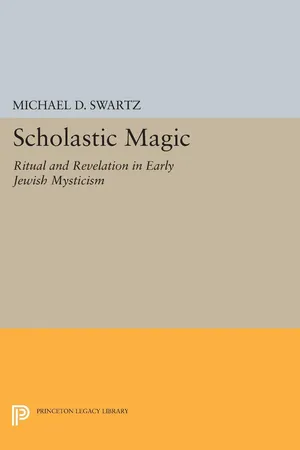
Princeton Legacy Library
Ritual and Revelation in Early Jewish Mysticism
- 278 pages
- English
- PDF
- Available on iOS & Android
About This Book
In exploring the social background of early Jewish mysticism, Scholastic Magic tells the story of how imagination and magic were made to serve memory and scholasticism. In the visionary literature that circulated between the fifth and ninth centuries, there are strange tales of ancient rabbis conjuring the angel known as Sar-Torah, the "Prince of the Torah." This angel endowed the rabbis themselves with spectacular memory and skill in learning, and then taught them the formulas for giving others these gifts. This literature, according to Michael Swartz, gives us rare glimpses of how ancient and medieval Jews who stood outside the mainstream of rabbinic leadership viewed Torah and ritual. Through close readings of the texts, he uncovers unfamiliar dimensions of the classical Judaic idea of Torah and the rabbinic civilization that forged them.Swartz sets the stage for his analysis with a discussion of the place of memory and orality in ancient and medieval Judaism and how early educational and physiological theories were marshaled for the cultivation of memory. He then examines the unusual magical rituals for conjuring angels and ascending to heaven as well as the authors' attitudes to authority and tradition, showing them to have subverted essential rabbinic values even as they remained beholden to them. The result is a ground-breaking analysis of the social and conceptual background of rabbinic Judaism and ancient Mediterranean religions. Offering complete translations of the principal Sar-Torah texts, Scholastic Magic will become essential reading for those interested in religions in the ancient and medieval world, ritual studies, and popular religion.Originally published in 1996.The Princeton Legacy Library uses the latest print-on-demand technology to again make available previously out-of-print books from the distinguished backlist of Princeton University Press. These editions preserve the original texts of these important books while presenting them in durable paperback and hardcover editions. The goal of the Princeton Legacy Library is to vastly increase access to the rich scholarly heritage found in the thousands of books published by Princeton University Press since its founding in 1905.
Frequently asked questions
Information
Table of contents
- Cover
- Contents
- Preface
- List of Abbreviations
- Part I: Introduction
- Part II: The Sar-Torah Texts
- Part III: Ritual and Revelation
- Part IV: Conclusions
- Bibliography
- Source Index
- General Index